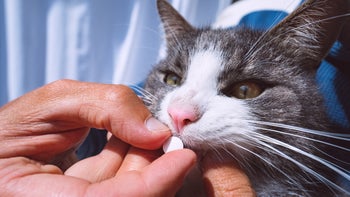
How to Trim Your Cat’s Nails: Tips, Tricks, and Tools You’ll Need
Key takeaways:
It’s important for your cat to get used to having feet before trimming their nails. This could take weeks or months, depending on your cat.
Tools like a guillotine- or nipper-style nail clipper, treats, and styptic powder or sticks are good to have in your tool kit when you clip your cat’s nails.
Trim your cat’s nails during a calm, relaxing time of day, such as nap time. Always be ready to stop clipping, or clip just a few nails if your cat is having a hard time.
Table of contents

Cat nail trimming is no easy task for most pet owners. You’ll be most successful at clipping cat nails if you start when they’re kittens. But regardless of your cat’s age, clipping their nails is an important part of your cat’s well-being — even if they don’t think so.
Learn more about how to clip your cat’s claws, what tools you need to make it easier, and when it’s time to pay a professional.
How to trim your cat’s nails
Follow these steps to successfully trim your cat’s nails.
Search and compare options
1. Get your cat used to the idea
The best way to trim your cat’s nails ideally starts by getting your cat used to having their paws and nails handled. This could take months or weeks of gentle touching.
Massaging the paws and giving your cat treats after will help them associate positive feelings with this process.
2. Consider a helper
If possible, it’s good to have two people working together to clip a cat’s nails, said Lori Bierbrier, DVM, the senior medical director for the eastern region at the ASPCA.
One person can wrap the cat in a towel and hold them while the other clips. Or one person can distract the cat with treats while the other uses the clippers.
3. Position your cat
Sit with your cat on your lap facing away from you. If your cat is very relaxed and lying down, approach them with the clippers in your hand.
4. Start with one paw
Gently handle your cat’s front paw in your hand. Use your fingers to press the cat’s toe, extending their claw.
Cat scratching your furniture? Read how real cat owners got their cats to stop scratching the furniture and start scratching better alternatives.
Brush your cat: Cats are self-groomers, but they still benefit from being groomed sometimes. Learn how often and when to brush your cat.
Cat-scratch disease: Cat-scratch disease may sound scary, but in most cases, it causes only mild problems. Get all the facts about this condition.
“Press on top of their nail to push the nail out, because cats retract their nails — [and] you can’t cut them while they’re retracted,” Bierbrier said.
5. Clip only the nail’s tip
Holding the clippers in your other hand, clip the tip of your cat’s nail. Stay away from the pink portion (the quick), keeping the blade closest to you.
“The really important thing when you’re first learning to cut nails is not to cut very much,” Bierbrier said. “Better to cut less than cut more and have it hurt or have the animal react.”
6. Clip the other front-paw nails
Do this one paw at a time for each nail on the front paw, and take breaks if needed. “I’ll definitely take a break if the cat is getting at all anxious or is not liking it,” Bierbrier said.
7. Move to the back paws
As long as your cat is still comfortable, move on to trim their back claws. Trimming the back paws can be tricker than the front. So if your cat won’t tolerate having their back paws trimmed, know that’s OK. The front nails are typically the ones that cause the most damage.
“It’s those front ones that are scratching up walls, carpets, other animals,” Bierbrier said. “So at least if I can get those two front feet done, I feel like I’ve had success.”
How short should you cut your cat’s nails?
You don’t need to trim your cat’s nails very short. “Just aim to trim the little hook off,” Bierbrier said. “The hook is what scratches and hooks onto things.”
You don’t want to cut your cat’s nails too short because this could cut into the quick of their nails.
Most cats have light-colored nails, and you’ll notice an area of pink blood vessels and nerves at the base of each one. That’s the nail quick, and you want to avoid cutting even near it. Because if you snip it, it will bleed. It can also hurt your cat.
If your cat’s nails are dark colored and you can’t see their quicks, make very small cuts to the top of the nail with the clippers.
What should you do if you cut the quick?
If you cut the quick on your cat’s nail, reach for your styptic powder or sticks if you have them on hand. Baking flour can be used as a substitute, but it doesn’t stop bleeding as well as styptic powder.
Take a little bit of the styptic powder (or flour) and put it on the area that is bleeding. Hold it there as best as you can. “That pressure and the powder together will stop the bleeding,” Bierbrier said. She added that the powder acts as a bandage.
Next, take a break and give your cat some treats. “The main thing is not to panic. The bleeding will stop,” Bierbrier said. “It’s not a crisis, but it can get a little messy.”
What tools should you use to trim cat nails?
There are three tools that will be helpful when you trim your cat’s nails. Let’s take a look.
Nail clippers
The first tool you’ll need to trim your cat’s nails is a nail clipper. Bierbrier said she recommends using a guillotine- or nipper-style nail clipper. Instead of crushing the nail, these clippers cut through it much more cleanly.
Styptic powder or sticks
Found at most pet stores, styptic powder helps blood coagulate and stop bleeding. The styptic acts as a bandage if you accidentally cut the quick of your cat’s nail.
Treats
Treats can serve as a distraction or reward before, during, and after your cat’s nail trim. Treats also help your cat start to associate nail trims with something positive — their favorite snacks.
When should you trim your cat’s nails?
Aim to trim your cat’s nails about once a month, Bierbrier said. But don’t be surprised if you see regrowth shortly after you’ve clipped.
“As they scratch, the old nail comes off and the brand-new one is under there,” she said. “So there is a certain amount of maintenance to keep them all trimmed.”
An ideal time to trim your cat’s nails is when they’re sleepy or relaxed rather than during a time of stress or playfulness. Keep in mind that you shouldn’t rush it.
Bierbrier said she recommends “having it be as calm as possible, as opposed to thinking I have to get them all trimmed [now].” It’s OK to stop anytime and come back to it later, she added.
When should you see a groomer or vet for your cat’s nails?
It’s time to see a veterinarian or a groomer for cat nail trims if your cat won’t let you do it. Some cats may run or hiss no matter what you do. If you have one of those felines, seek help from professionals rather than risk hurting yourself or your cat.
You may also be surprised to learn that if you don’t clip your cat’s nails, they will be just fine.
“Do they have to have their nails trimmed? No,” Bierbrier said. “The really cool thing about cats is that they shed their nails, so they have a brand-new sharp nail underneath. It’s pretty rare for cats to have problems with their nails if they’re not trimmed.”
The bottom line
Cats don’t need to have their nails clipped. But if you want to prevent scratching damage around your house, you can safely trim them at home. It’s best to start by slowly introducing your cat to the nail process. When you’re ready to trim, take your time. Start with one front paw at a time, and clip only the tip of each nail. Take care to avoid the quick of your cat’s nail. Cutting in the quick is painful for cats and will cause bleeding. Make sure you have cat-specific nail trimmers on hand as well as styptic powder to stop bleeding if you cut the quick.
Why trust our experts?



References
Nugen, S., et al. (2021). Desensitization and counterconditioning to nail trimmers for cats. Veterinary Partner.
Schwarz, K. (2021). Nail trims for adult cats. Veterinary Partner.
Washington State University College of Veterinary Medicine. (2022). How to clip a cat’s nails.

























